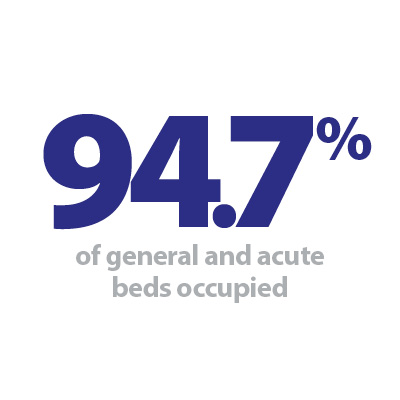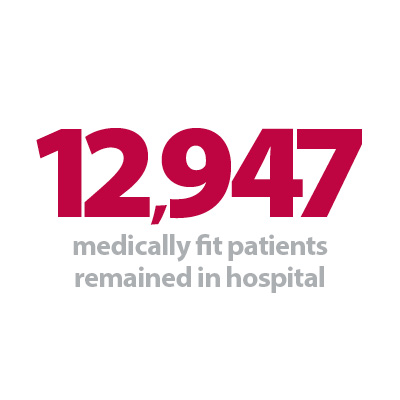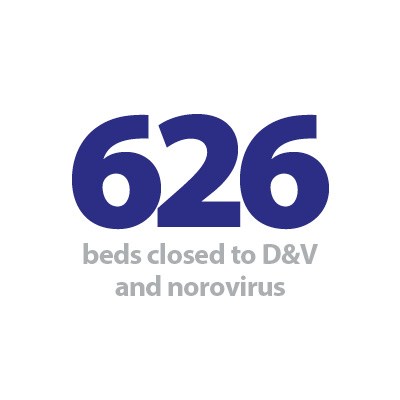


Introduction
Yesterday the weekly winter situation reports by NHS England were published, alongside the monthly performance and activity statistics. These offer valuable insight into the situation on the ground as trusts prepare for what is likely to be another hard winter for the NHS.
These data continue to show how staff are working tirelessly under severe pressures to clear care backlogs while responding to the demand, the rise in the usual seasonal illnesses, and system wide pressures.
This week's winter data (4 – 10 December) show more people are in hospital with flu and norovirus, and continues to highlight ongoing issues with patient flow, with a higher proportion of patients remaining in hospital despite being medically fit to leave.
Meanwhile, the monthly activity and performance statistics provide useful context to the state of the sector. Key points to highlight include:
Ambulance activity: The number of category 1 incidents in September decreased compared to the month before but remains higher than the equivalent period before the Covid-19 pandemic. Average response times for category 1 and category 2 incidents improved in the latest month but both targets were missed.
Emergency care activity: The monthly number of attendances dropped to 2.2m in September, but performance has not met the national performance standards. The number of patients waiting for admission more than 12 hours from the decision to admit has decreased by 4%.
Elective care: Elective care activity increased from the previous month and the waiting list has fallen by around 1%, though remains high at 7.7m. The number of those waiting more than 78 weeks has increased this month, but those waiting longer than 52 weeks has decreased.
Diagnostics: Activity increased in October with almost 2.3m diagnostic tests carried out, the second highest month on record. However, the diagnostic waiting list remains high at 1.6m.
Cancer: Activity has increased for the 28-day faster diagnosis standard, as well as an improvement in performance with a higher proportion of patients told an outcome of their cancer diagnosis within 28 days of an urgent GP referral for suspected cancer.
Urgent community response: As of September 2023, 85% of urgent community response referrals met the two-hour standard for delivering urgent community response services.
Mental health: The number of people in contact with mental health services has increased in October and remains considerably higher than pre-pandemic levels.
Winter situation report (4 – 10 December)
A&E closures and diverts: There were no A&E closures this week. There were a total of 20 A&E diverts, two fewer than the week prior.
Adult critical care: Critical care bed occupancy is at 81.7%, an increase from 80.1% last week and higher than a year ago (80.1%).
Ambulance arrivals: A total of 84,268 patients arrived by ambulance. This is similar to last week.
Ambulance handovers: 33.8% of ambulance handovers were delayed by 30 minutes or more, up from 26.9% last week. 15.2% were delayed by 60 minutes or more, this is up from 9.8% last week. A total of 31,415 hours were lost to ambulance handover delays.
Diarrhoea and Vomiting (D&V): The number of beds closed due to D&V has increased this week with an average of 626 beds closed per day. This is up from 499 last week.
Discharges: There were an average of 23,245 patients each day who no longer met the criteria to reside, a decrease of 198 patients from the week before. Of these, 55.7% (or 12,947) remained in hospital.
Flu: This week the average number of general and acute (G&A) beds occupied by flu patients each day increased to 384 from 234 last week. An average of 18 critical care beds were occupied by flu patients each day this week (double the number from the week before).
G&A beds: There were an average of 101,260 G&A beds open each day. On average each day, 81 beds were unavailable and void to non-Covid infections. Average bed occupancy remains high at 94.7%, an increase of 0.2 percentage points compared to the same week last year.
Long stay: The number of patients staying in hospital longer than seven, 14, and 21 days all increased slightly this week (up by 0.7%, 0.4%, and 0.5% respectively). Compared to the same time last year, these have all decreased (down by 2.1%, 3.7%, and 4.5% respectively).
Neonatal intensive care beds: For all trusts, bed occupancy has increased from last week and is at 70%; this is up from 67.4% last week. The average number of care beds open is 1,707, four fewer than last week.
Paediatric intensive care beds: For all trusts, bed occupancy has fallen to 85.5%, down from 86.4% last week. The average number of care beds open this week has remained at a similar level to last week (364).
Respiratory syncytial virus (RSV): An average of 124 beds were closed this week due to RSV symptoms, down from 162 last week and broadly in line with last year.
Staff absences: There were an average of 49,020 absences each day this week, of which 4% were Covid-19 related (1,968). The total number of staff absences increased from the week before (47,018) and the proportion of Covid-19 related absences was greater (up from 3%).
Our view
This week's figures once again give cause for concern, with services in all sectors facing immense pressures as temperatures drop and virus-related cases rise.
At the same time, the latest performance data shows progress is being made in reducing the elective care backlog. We have also seen an improvement in response times with ambulances responding to category 2 incidents more quickly than the same time last year.
Last winter was one of the most challenging periods in the history of the NHS. Yesterday's performance data shows the scale of the task currently facing trusts and suggests there are more tough times ahead. This, more than ever, demonstrates the importance of finding a resolution to the ongoing industrial action disputes, so trusts and staff can continue to meet increasing levels of demand while and tackling care backlogs.
New REACT service helps patients in the last year of life receive treatment and care at home
Dr Ray Smith, chief medical officer at Bradford Teaching Hospitals NHS Foundation Trust discusses how the Marie Curie Responsive Emergency Assessment and Community Team (REACT), a virtual ward, is reducing hospital stays for terminally ill patients. The scheme, which aims to help keep patients with a terminal diagnosis out of hospital and cared for in the comfort of their own homes, has seen its 600th patient.
The Marie Curie REACT virtual ward has been working with palliative medicine consultants at Bradford Royal Infirmary (BRI), part of Bradford Teaching Hospitals NHS Foundation Trust, since June 2022 after receiving funding for the three-year pilot from Social Finance UK.
The scheme was instigated after data showed that end-of-life patients spent an average of a month in hospital in the last year of their life. In the first year of the pilot, the team has seen days spent in hospital more than halved, from an average of 38 bed days per year to 17. Palliative care consultants visit the BRI's A&E every morning to identify patients who might benefit from the service. With the right plans in place, patients can be discharged into the care of Marie Curie's REACT team for 72 hours, until mainstream services can take over.
Palliative medicine consultant, Dr Clare Rayment, said: "We know that for many patients with a terminal diagnosis, a hospital admission can be very upsetting and provide a poor experience for patients and their families.
"Often, in a crisis, the place people come to is A&E but research tells us that hospital might not be the best place for them. Under REACT, we are now able to offer an alternative to that and an alternative to hospital as the virtual ward enables people to return home with care being provided by our colleagues in Marie Curie and this has halved the number of days patients spend in hospital in the last year of their life.
"It's a joint decision-making process with the patient about what matters most to them and what their priorities are, knowing that they're not going to get better. We know that the majority of patients, at the end of their lives, would prefer to be cared for at home, rather than in hospital. REACT makes their wishes possible."
The REACT service is being piloted over three years – from June 2022 to June 2025 – to see how well it can help patients receive the care they need in the comfort of their own home.
Marie Curie UK's chief medical officer, Dr Sarah Holmes, who is based at Bradford's Leeds Road Hospice, stated: "We are delighted with how this innovative service has made a real difference so quickly.
"One of the reasons it was developed was in recognition of the unmet palliative care needs across Bradford. This has proven very much to be the case as many of those REACT has helped over the past year had previously been struggling to access appropriate care, for a variety of reasons.
"This partnership has not only helped them receive quality, joined-up care tailored to their need, it is also reducing the time they're spending in hospital, often including crisis visits to A&E."
Patient, Michael Busfield, from Bradford, has chronic obstructive pulmonary disease and has been cared for by the Marie Curie REACT team at home following an emergency admission to the BRI's A&E department recently.
He said: "One minute I can be fine and talking normal, but the next I might be out of it and can't breathe.
"It's great. I am happy to be home again – I'm my own boss again."
The REACT service is fully funded by the End-of-Life Care Integrator through a 'social impact bond' which lasts the duration of the pilot. The funding for the pilot is managed by Social Finance with social investment from Big Society Capital, Macmillan Cancer Support and the Commissioning Better Outcomes Fund.
This month, the Marie Curie REACT team started accepting direct referrals from community services and organisations such as Airedale's Goldline.